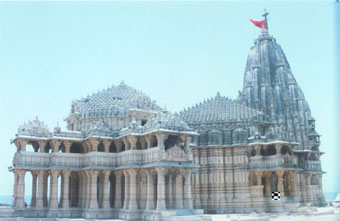-:
Hindu Temples :-
Lord Krishna Temples
Dwarka Temple

Dwarka, on the west coast of Gujarat on the shore of the Arabian Sea, features in most of the legends surrounding Lord Krishna. It is from here that the grown Lord Krishna is supposed to have ruled his kingdom. Dwarka is a significant pilgrimage site for the Hindus
Dwarka is sanctified as the place where Lord
Vishnu slew the demon Shankhasura. The Puranas mention the 12 Jyotirlingas
or columns of light representing Lord Shiva which manifested in different
parts of the country. One of these is located in Dwarka and is known as the
Nageshwar Mahadev. The Jagat Mandir or Nij Mandir forms the sanctum of the
Dwarkadish temple and dates back to 2500 years. Jagat Mandir has its own
hall of audience and a conical spire. The roof of the hall is supported by
60 columns and the main temple rises five storeys high. The spire rises to a
height of 157 feet and is richly carved. One of the most popular temples in
Dwarka is that of Rukmini, Krishna's wife, considered an incarnation of
Goddess Lakshmi, the goddess of wealth and beauty. The Sharad Peetha, one of
the four Maths established by Jagatguru Shankaracharya, is also situated
here.
Location
Dwarka is situated in the extreme west of the Indian state of Gujarat in the
Saurashtra peninsula on the Arabian Sea. It lies on 20°22' north latitude
and 69°05' east longitude. The city is built on the right bank of Gamut
creek.
History
Dwarka is an important pilgrimage center. It is steeped in legends, being
associated with the life of Lord Krishna. In Puranic times, present-day
Dwarka was known as Kushasthali or Dwaravati and enjoyed pride of place as
the most important spot on the Saurashtra coast. It is said that Lord
Krishna, after slaying Kansa, left his abode at Mathura and traveled with
the entire Yadava community to the coast of Saurashtra where he founded a
town and named it Swarnadwarika.
Vajranabh, Lord Krishna's successor and great grandson, is believed to have
built the present temple Dwarkanath, also called Trilok Sundar. Many Hindus
fervently believe that the temple was erected in one night by a supernatural
agency, under Vajranabh's direction. Legend has it that when dying, Lord
Krishna asked his devotees to leave Swarnadwarika so that the sea could
engulf it. Until this day, Lord Krishna's city lies buried under the sea.
Excavations have revealed that the sea swallowed five settlements, the
present-day Dwarka being the sixth in line.